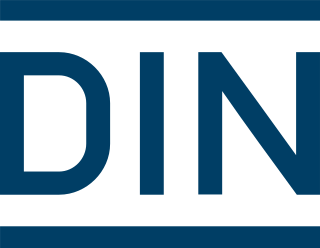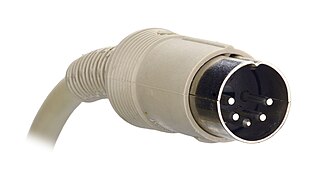
Deutsches Institut für Normung e.V. is a German non-profit organization and acting as national organization for standardization. DIN is the German ISO member body. DIN is headquartered in Berlin. There are around thirty thousand DIN Standards, covering nearly every field of technology.
ISO 3166 is a standard published by the International Organization for Standardization (ISO) that defines codes for the names of countries, dependent territories, special areas of geographical interest, and their principal subdivisions. The official name of the standard is Codes for the representation of names of countries and their subdivisions.

Scaffolding, also called scaffold or staging, is a temporary structure used to support a work crew and materials to aid in the construction, maintenance and repair of buildings, bridges and all other human-made structures. Scaffolds are widely used on site to get access to heights and areas that would be otherwise hard to get to. Unsafe scaffolding has the potential to result in death or serious injury. Scaffolding is also used in adapted forms for formwork and shoring, grandstand seating, concert stages, access/viewing towers, exhibition stands, ski ramps, half pipes and art projects.
DIN 31635 is a Deutsches Institut für Normung (DIN) standard for the transliteration of the Arabic alphabet adopted in 1982. It is based on the rules of the Deutsche Morgenländische Gesellschaft (DMG) as modified by the International Orientalist Congress 1935 in Rome. The most important differences from English-based systems were doing away with j, because it stood for in the English-speaking world and for in the German-speaking world and the entire absence of digraphs like th, dh, kh, gh, sh. Its acceptance relies less on its official status than on its elegance and the Geschichte der arabischen Literatur manuscript catalogue of Carl Brockelmann and the dictionary of Hans Wehr. Today it is used in most German-language publications of Arabic and Islamic studies.

The DIN connector is an electrical connector that was standardized by the Deutsches Institut für Normung (DIN), the German Institute for Standards, in the mid 1950s, initially with 3 pins for mono, but when stereo connections and gear appeared in late 1950s, versions with 5 pins or more were launched. The male DIN connectors (plugs) feature a 13.2 mm diameter metal shield with a notch that limits the orientation in which plug and socket can mate. The range of DIN connectors, different only in the configuration of the pins, have been standardized as DIN 41524 / IEC/DIN EN 60130-9 ; DIN 45322 ; DIN 45329 / IEC/DIN EN 60130–9 ; and DIN 45326 / IEC/DIN EN 60130-9.
Sound energy density or sound density is the sound energy per unit volume. The SI unit of sound energy density is the pascal (Pa), which is 1 kg⋅m−1⋅s−2 in SI base units or 1 joule per cubic metre (J/m3).
ISO 7736 is a standard size for dashboard mounted head units, for car audio. It was originally established by the German national organization for standardization, the Deutsches Institut für Normung, as DIN 75490, and is therefore commonly referred to as the DIN size. It was adopted by the International Organization for Standardization in 1984.

Austrian Standards International, abbreviated ASI, is a standards organization and the ISO member body for Austria.

The German national standard DIN 5008 by Deutsches Institut für Normung (DIN) specifies writing and layout rules for word processing. As such it is one of the fundamental standards for office communication and administrative work in Germany. Today, the standard is maintained by the Normenausschuss Informationstechnik und Anwendungen – Fachbereich Bürotechnik, Bankwesen und elektronisches Geschäftswesen.

Diving equipment, or underwater diving equipment, is equipment used by underwater divers to make diving activities possible, easier, safer and/or more comfortable. This may be equipment primarily intended for this purpose, or equipment intended for other purposes which is found to be suitable for diving use.
The Municipal Services Standards Committee (NKT) of the German Institute for Standardization (DIN) is responsible for standardisation in the field of waste management and city cleaning. It chairs a number of European standardisation committees (CEN) and it issues specifications on technical and logistical aspects in waste handling, road cleaning, highway maintenance and winter service.
DIN EN ISO 9712:2012 is a certification issued by the German institute for standardization. It certifies personnel working in Non-destructive testing. This standard evaluates and documents the competence of personnel whose tasks require knowledge of non-destructive tests. The certification process is performed by authorized independent certification bodies, such as Sector Cert, DQS, TÜV, DEKRA etc. They can be applied at the German accreditation body.
The EEG DIN connector is an electrical connector used to connect medical and biomedical recording systems, such as electrodes for electroencephalography.

DIN 7876 is a German standard specifying how swimming fins should be dimensioned, tested and marked for conformity. In 1980, the Deutsches Institut für Normung (DIN) published consecutively numbered German standards DIN 7876, DIN 7877 and DIN 7878 dedicated respectively to the swimming fin, the diving mask and the breathing tube, which constitute basic underwater diving equipment. DIN 7876 of October 1980 is entitled Tauch-Zubehör – Schwimmflossen – Maße, Anforderungen und Prüfung in German and subtitled “Diving accessories for skin divers; Flippers, dimensions, requirements and testing” in English. This standard establishes certain quantitative and qualitative specifications for swimming fins, with particular reference to foot pockets and heel straps. Swimming fin manufacturers fulfilling such requirements may mark their products as compliant with this standard. The status of DIN 7876 is currently zurückgezogen, meaning: “withdrawn”.

Medical gowns are hospital gowns worn by medical professionals as personal protective equipment (PPE) in order to provide a barrier between patient and professional. Whereas patient gowns are flimsy often with exposed backs and arms, PPE gowns, as seen below in the cardiac surgeon photograph, cover most of the exposed skin surfaces of the professional medics.
The Regeln für die alphabetische Katalogisierung or RAK are a bibliographic cataloging set of rules. The RAK rules appeared for the first time in 1976 and became the dominant set of rules in Germany and Austria in the 1980s.

Holger Mühlbauer is a German jurist and writer, focused on technical standards and information security, working for the German DIN as managing director of a committee, for the Austrian Standards, the European Committee for Standardization (CEN) and the International Standards Organisation (ISO). He is managing director of TeleTrusT, and author of specialist books.
The German national standard DIN 5009“Word and information processing for office applications — Announcing and dictating of text and characters” by Deutsches Institut für Normung (DIN) provides rules for the spoken announcement of texts to be written afterwards. In addition to the classic phono dictation, it specifically supports oral communication about names and texts that have to be written down correctly.








